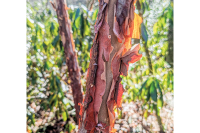Weighing the Pigeon’s future: Public hearing spurs robust turnout for and against paper mill permit
 U.S. 23 crosses the Pigeon River just upstream from the discharge site at Evergreen Packaging in Canton. Evergreen Packaging photo
U.S. 23 crosses the Pigeon River just upstream from the discharge site at Evergreen Packaging in Canton. Evergreen Packaging photo
State of residence was the most visible dividing line in an April 14 hearing on the proposed terms for a renewed wastewater discharge permit at the Evergreen Packaging mill in Canton.
During the three-hour hearing, held online via Cisco Webex, 30 people gave the Department of Environmental Quality their thoughts on the matter, 16 against the permit and 14 in favor. All 14 supporters work or reside in Haywood County, and most of them were either mill employees or public officials.
Of the 16 opponents, about half were Tennessee residents living downstream from the mill, and most of those were whitewater rafting guides or paddling enthusiasts who have frequent contact with the water. Other opponents represented various environmental organizations, and one was a Haywood County resident who lives near the Tennessee state line at Waterville Lake.
Since its establishment in 1908, Canton’s paper mill has been central to both Haywood County’s identity and its economy, currently employing 1,100 people at some of the highest wages available in the area. However, the mill’s initial success came at a high environmental price. Those who were around in the 1980s and 1990s remember a jet-black river ferrying large blocks of foam and all but devoid of indigenous aquatic life.
The river looks a lot better these days. Since 1990, Evergreen Packaging has spent more $500 million in environmental improvements, reducing its total discharge by one-third and color discharge by more than 90 percent. Fish consumption advisories, which had previously been the rule rather than the exception, were lifted one by one in the late ‘90s and early 2000s, and now not a single fish consumption advisory is in effect on the Pigeon River.
However, critics of the mill contend that although the progress is laudable, the work isn’t done. The permit hearing was a once-in-a-decade chance to make their concerns known.
Related Items
The mill’s last permit renewal process concluded in 2010, with additional terms added in 2012 after a successful lawsuit from a group represented by the Southern Environmental Law Center — it included several environmental organizations and the government of Cocke County, Tennessee. The 2010 permit expired in 2015, but even though the mill submitted its renewal paperwork on time, the state is just now, six years after that expiration, reaching the point of approving a new permit. Division of Water Resources Spokesperson Anna Gurney said the delay was due to recent changes to variance regulations requiring the department to learn a new process, extensive negotiations between the U.S. Environmental Protection Agency and the mill, and the pandemic.
‘One of the nastiest rivers’
Opponents of the proposal say that 10 years is too long to wait for a new permit that does nothing to move the needle forward on environmental standards and in some areas opens the door to backsliding — especially for downstream residents who receive all of the mill’s pollution but none of its economic benefits.
“A lot of people from the Canton area look at it purely from their own financial viewpoint,” said Donna Norris, a lifetime Cocke County resident who owns a wedding chapel along the river. “Downstream, the water quality affects us as well. We deserve to benefit from the river that runs right through us.”
Right now, multiple speakers said, that’s not happening to the extent that it should. The DEQ heard from residents who were afraid to let their dogs swim in the river and river guides who said the pollution gave them rashes and left a terrible taste in their mouths that could last for hours after a kayak roll.
“It is one of the nastiest rivers I’ve paddled in the entire country, and I’ve paddled at least 100 rivers,” said whitewater guide Amelia Taylor.
Speakers from Cocke County expressed particular concern about a proposal concerning the color variance. Since the 1980s, the mill has received a variance on color loading, which basically means that because they weren’t able to meet the same standard the state imposes on everybody else using currently available technology, they received special permission to abide by a looser standard that permits more color loading than would typically be allowed.
Since 1990, the mill has reduced its color discharge by more than 90 percent. It’s now able to meet the normal state standard and so does not need a variance. That’s good news, but opponents of the proposal said they want to see permit conditions that would push the mill toward continued reductions in color loading. The mill is already meeting the state standard, so removing the variance would not require it to improve its performance.
“The proposed in-stream standard is actually weaker than the standard the EPA proposed over 30 years ago in the 80s,” said Hope Taylor, recently retired executive director for Clean Water of North Carolina. “It must be lower, not higher, as proposed by the conditions in this draft permit.”
Color was far from the only permit term at issue during the hearing.
“The current draft permit either does not do enough to protect the Pigeon or invites backsliding on key terms,” said Spencer Scheidt, associate attorney at the Southern Environmental Law Center.
Both Scheidt and Callie Moore of MountainTrue called for water temperature limits based on daily monitoring rather than monthly averages.
The manufacturing process releases substantial amounts of heat into the river water it uses, and if the water is too hot when it’s discharged back into the river, the aquatic ecosystem suffers. In summer 2007, an extremely hot water discharge from the mill killed more than 8,500 fish, but because the permit regulated temperature based on monthly averages, the episode didn’t constitute a permit violation.
No big fish kills have occurred since then, but permit opponents say that there’s nothing stopping a repeat performance — especially since the proposed permit would move back to monthly temperature calculations after using weekly numbers since the terms of the 2012 settlement were enacted. Further, they say, the downstream aquatic community is already suffering due to higher-than-natural water temperatures.
“I see the studies that talk about, ‘there’s an indigenous fish community,’ but smallmouth bass and some of the other species that are mentioned are more cool-water, not coldwater species,” said Moore. “The water coming to the plant is a coldwater river, so we should strive to match that as much as possible.”
Scheidt also criticized the fact that neither the permit nor the mill’s application address levels of PFAS, also known as “forever chemicals,” contending that the paper industry is a known consumer of those materials. Both he and Moore slammed a provision in the proposed permit that would require the mill to test fish for dioxin levels just once over the permit’s life. Currently, the mill must perform this testing three times in the five-year permit period.
The mill contends that more frequent testing is not necessary, because no dioxin has been detected in its discharge since 1989. However, environmental advocates point out that the chemical still persists in the environment. Frequent testing should continue until fish tissue tests free of the chemical, Moore said, adding that because the current five-year permit is now in its 11th year of use, the effective frequency of testing could be far less than once every five years.
Moore also told the DEQ that she was concerned about the increase in allowable chloroform discharge under the new proposed permit. The increased limit is due to revised guidance from the EPA. However, the mill was already meeting a stricter standard and so is clearly able to continue doing so, she said.
“If the mill is able to meet the existing permit limits, which are more strict, then why should we allow more?” she said. “Many of the mills across the EPA region and the United States are not being fed by pristine, high-quality and outstanding resource waters flowing out of national forests and wilderness areas. I just think the placement of this mill should be taken into consideration when you’re talking about allowing more pollution of something like chloroform into the river.”

A kayak-view photo looks upstream from the paper mill site in Canton. Anna Alsobrook/MountainTrue photo
Lifeblood of Canton
The mill’s proponents did not spend much time addressing the particular provisions of the proposed permit. Instead, they focused on highlighting Evergreen’s importance to the community and its impressive cleanup efforts over the past couple decades, couching the proposed color variance removal as a mark of victory following a long and expensive struggle to restore the river.
“We feel we should have recognition of this accomplishment and have the color variance removed from the permit since our efforts have made it unnecessary,” said Evergreen Operations Manager Jay Clary. “The employees have earned the right to have this color variance removed.”
Canton Mayor Zeb Smathers told the DEQ about the marked difference between his earliest memories of the river as a child in the 1980s and the view today.
“I remember how it looked. I remember how it smelled,” said Smathers. “I remember the foam. I remember how people treated that mill below the river. That has changed. It is amazing to me not just the amount of money that has been put into making the river quality and water quality better, but just the intentional push by mill leaders and your everyday workers to do better. This is not a company that is doing something because they have to. They want to. They want to be good community partners.”
Smathers went on emphasize the mill’s importance to the town of Canton, saying that the mill is Canton’s “lifeblood” and that “you cannot separate the DNA of Canton, North Carolina, from Evergreen Packaging.” He pointed to the fact that the mill processes the town’s wastewater as an example of the “linked” relationship between Canton’s mill and its government.
Haywood Chamber of Commerce President CeCe Hipps spoke about the respect she gained for the mill as a result of her father-in-law’s 44-year career there and applauded Evergreen’s “transparent” environmental efforts.
“While the past may have been shaky at times, the current leadership and their engagement and investment in the future of the community looks very promising,” she said.
“It’s just critical to our economy,” said County Manager Bryant Morehead, noting the fact that Evergreen employs 1,100 people in Haywood County with an annual payroll of $95 million.
Evergreen’s Director of Sustainability Derric Brown cited the mill’s past successes in environmental cleanup, saying that surveys now show balanced indigenous fish communities where before there were none and record-breaking numbers of rafters in the river. On top of that, he said, the Canton mill has one of the cleanest water discharges of any mill in the world.
“If you take two glass jugs of water to compare, one of them filled upstream of the mill and one of them filled at the Tennessee state line, the human eye can’t tell the difference between the two,” added Steve Hutchins, a member of the mill’s leadership team.
Two Haywood County commissioners drew attention to the mill’s role in reducing pollution worldwide, with Commissioner Tommy Long pointing to the continued deluge of plastic water bottles into landfills and waterways as an “environmental disaster.”
“I think lost in this discussion is what product the Canton packaging mill produces,” he said. “It’s basically a biodegradable liquid container. That’s the bulk of their business. We seldom ever pick up a biodegradable container. It’s basically plastic water bottles and aluminum cans.”
Commission Chairman Kevin Ensley expressed similar sentiments, adding that manufacturing in Canton is much cleaner than manufacturing in other parts of the world.
“I’d a lot rather paper be made in America than an overseas country like China where the environment is not even though of,” he said.
Ensley noted that he has owned property on Douglas Lake in East Tennessee for 17 years and has not observed any water quality issues that interfere with swimming, fishing and boating. The lake is fed by the Nolichucky, Pigeon and French Broad rivers.
The road ahead
The public hearing is past, but it’s not too late to weigh in on the permit terms. The DWR is accepting written comments through April 30. After that, staff will sift through the feedback and come to a final decision, expected in May. The resulting permit will be good through 2026.
As they evaluate study results and technical considerations, staff may hear a soundtrack play in the back of their minds, composed of the pleas of those for whom the river is an essential part of life — Haywood County residents begging the state to recognize their mill’s good work and to forestall any decision that could spell its financial doom, and Cocke County residents imploring North Carolina’s government to give the health and wellbeing of Tennessee’s people the same weigh they do their own taxpayers.
Then, a third voice — that of the environmental groups that have taken it upon themselves for decades to seek judicial and federal remedies to what they see as high pollution levels state regulators allowed to persist.
“The work to restore the Pigeon River to health is still far from over,” Taylor said.
Be heard
Written comments on the proposed wastewater permit for Blue Ridge Paper in Canton will be accepted through Friday, April 30.
The permit, expected to be issued in May, would be in effect through at least May 2026. Due to delays with the regulatory agencies, the mill has been operating on an extension of its current permit, issued in 2010, since 2015.
For more information, including links for commenting and for reading the proposed permit, visit bit.ly/cantonpermit. Watch the April 14 public hearing at bit.ly/3duDhcs.













